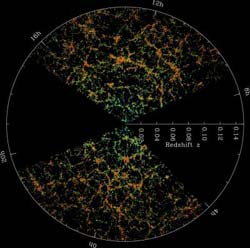Scientists model physics of a key dark-energy probe

Produced by the Sloan Digital Sky Survey, this three-dimensional map of the distribution of galaxies shows Earth at the center, and represents each galaxy with a single point. Large astronomical surveys, such as SDSS, rely upon a model of Baryon Acoustic Oscillations to provide a cosmological "standard ruler" for determining length scale. Ohio State University's Chris Orban and David Weinberg, Ph.D., have employed Ohio Supercomputer Center resources to simplify and better characterize that BAO model. Credit: M. Blanton and SDSS<br>
Ohio State University researchers are leveraging powerful supercomputers to investigate one of the key observational probes of “dark energy,” the mysterious energy form that is causing the expansion of the universe to accelerate over time.
The OSU project, led by Chris Orban, a graduate research fellow in physics at Ohio State's Center for Cosmology and Astro-Particle Physics, focuses on simulations created on Ohio Supercomputer Center (OSC) systems to simplify and better characterize a subtle dark matter clustering feature. The new model allows cosmologists to gain a more accurate understanding of certain aspects of large-scale structure, such as the effect of the expansion of the universe on the growth of density fluctuations.
“Knowing how the dark matter 'reacts' to the expansion of the universe is crucial for learning the most about dark energy and dark matter from large astronomical surveys like the Sloan Digital Sky Survey, of which OSU is a collaborating member,” said Orban. “In particular, there is a subtle clustering feature seen in this data set called 'Baryon Acoustic Oscillations' (BAO), which turns out to be very useful for constraining cosmological parameters like the equation of state of dark energy.”
The oscillations come from fluctuations in the distribution of hot plasma in the early universe; researchers can identify this feature by measuring the cosmic microwave background.
“The BAO signature gets imprinted on the dark matter very early on, but the feature changes over cosmic time, potentially biasing its use as a cosmological tool,” Orban explained. “It's a complicated non-linear problem, and physicists are very fond of simplifying complicated problems to gain a more in-depth understanding. This is exactly what we did for the first time, in our paper, using N-body simulations.”
“For current state-of-the-art astronomical surveys, the main non-linear effects that we investigate in the paper are negligible compared to other sources of error, but next-generation surveys will need to be far more sophisticated in this regard,” said Orban's academic advisor, David Weinberg, Ph.D., who is a professor of astronomy at OSU and the project scientist for the Sloan Survey. “This places the utmost importance on making reliable and precise predictions for these non-linear effects, a task which cosmological N-body simulations are in many ways well-suited to do.”
Since early 2009, Orban and Weinberg have employed nearly 200,000 processor-hours of computational time on the OSC's flagship Glenn Cluster and eight terabytes of storage space on its Mass Storage Environment. The Glenn Cluster offers researchers more than 9,600 Opteron cores, 24 terabytes of memory and a peak computational capability of 75 teraflops – which translates to 75 trillion calculations per second.
For software, the researchers employed the state-of-the-art Gadget-2 N-body code to calculate the trajectories of more than a hundred million particles, and set the initial conditions using the 2LPT code developed by their collaborators at New York University.
“This research project represents a fantastic conjunction of people and disciplines,” observed Ashok Krishnamurthy, co-executive director of OSC. “It brought together professionals in the fields of physics, astronomy and computational science to produce impressive results that might not otherwise have come together for many years. OSC is proud to have contributed to these achievements.”
Orban and Weinberg authored a paper on this research, “Self-similar Bumps and Wiggles: Isolating the Evolution of the BAO Peak with Power-law Initial Conditions,” which is slated for publication in the journal Physical Review D.
“We're both pretty proud of the final product, which we've been working on for about two and a half years,” Orban said. “Our production runs represent by far the largest set of cosmological simulations ever performed at The Ohio State University.”
Media Contact
More Information:
http://www.osc.eduAll latest news from the category: Physics and Astronomy
This area deals with the fundamental laws and building blocks of nature and how they interact, the properties and the behavior of matter, and research into space and time and their structures.
innovations-report provides in-depth reports and articles on subjects such as astrophysics, laser technologies, nuclear, quantum, particle and solid-state physics, nanotechnologies, planetary research and findings (Mars, Venus) and developments related to the Hubble Telescope.
Newest articles

Properties of new materials for microchips
… can now be measured well. Reseachers of Delft University of Technology demonstrated measuring performance properties of ultrathin silicon membranes. Making ever smaller and more powerful chips requires new ultrathin…

Floating solar’s potential
… to support sustainable development by addressing climate, water, and energy goals holistically. A new study published this week in Nature Energy raises the potential for floating solar photovoltaics (FPV)…

Skyrmions move at record speeds
… a step towards the computing of the future. An international research team led by scientists from the CNRS1 has discovered that the magnetic nanobubbles2 known as skyrmions can be…





















